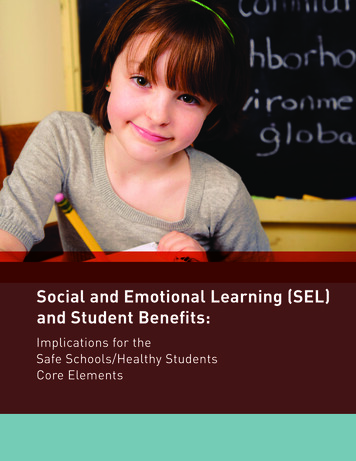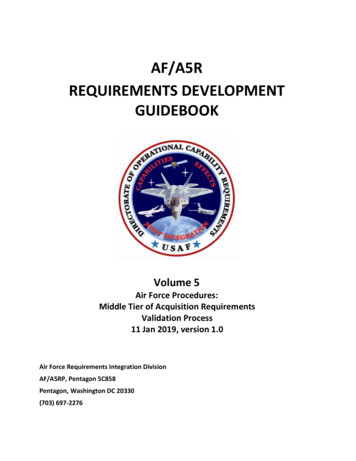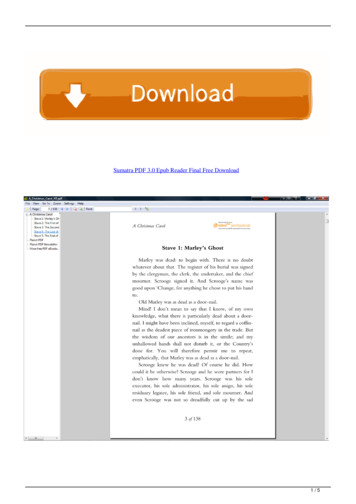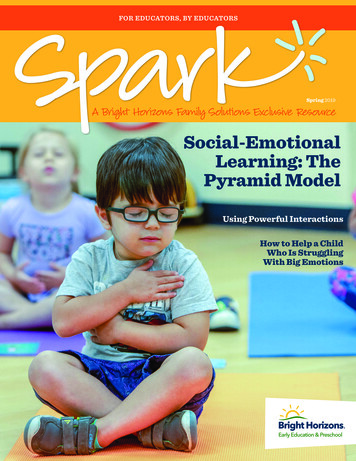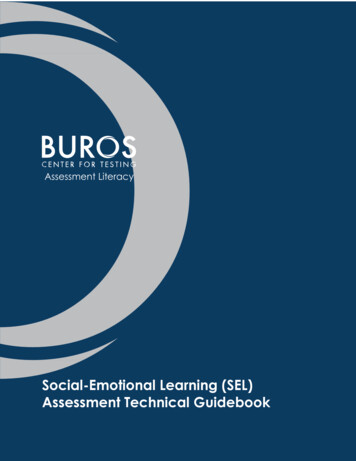
Transcription
Assessment LiteracySocial-Emotional Learning (SEL)Assessment Technical Guidebook
2020This guidebook maybe be copied and reproduced for educational andresearch purposes. When disseminating cite Buros Center for Testing andSpencer Foundation’s role in this work.Buros Center for Testing–Spencer Foundation Project Scholars (2020). SocialEmotional Learning Assessment Technical Guidebook. k
Table of ContentsAbout the Project and Guidebook1Buros-Spencer Project Scholars2Introduction to SEL Assessment Technical Guidebook3Guide 1: Locating and Identifying a SEL Assessment5Guide 2: Evaluating the Measurement Quality of a SEL Assessment10Guide 3: Recommendations when Using Social and Emotional Learning (SEL) Assessments 12Appendices16
About the Project and the GuidebookIn the past decade, there has been an increasing interest in the measurementof students’ social and emotional learning (SEL) for decision-making purposes invarious educational contexts. Federal and state educational policies indicatetrends in basing accountability and improvement for student learning on morethan just cognitive skills. There is also an increasing emphasis on the use of theseskills in college admissions decisions in addition to K-12 learning.The use of non-cognitive measures has prompted concerns regarding thevalidity, reliability, and fairness particularly when making high-stakes decisions.Professional testing standards exist that generally address the need for evidenceto support these elements of an assessment. However, SEL assessments poseunique challenges due to different types of validity threats and potential fairnessissues that accompany them.Therefore, the primary goal of this project led by the Buros Center for Testing andfunded by the Spencer Foundation was to bring together the most informedpsychometric scholars in SEL research to synthesize what is currently known andunknown about the validity, reliability, and fairness of these measures forprimarily educational uses. This knowledge was then applied to develop a list ofguidelines for educators as to the most important considerations to make beforeselecting or using SEL assessments for decision-making purposes.Questions about this SEL Assessment Technical Guidebook can be directed toDr. Jessica L. Jonson, jjonson@buros.org.SEL Assessment Technical Guidebook Buros Center for Testing1
Buros-Spencer Project ScholarsJeremy BurrusACTSusanne DenhamGeorge Mason UniversitySteve ElliottArizona State UniversityJessica L. JonsonBuros Center for TestingUniversity of Nebraska–LincolnRandy KamphausUniversity of OregonMichael RodriguezUniversity of MinnesotaKurt F. GeisingerBuros Center for TestingUniversity of Nebraska–LincolnNeal SchmittMichigan State UniversityLaura S. HamiltonRAND CorporationBeverly J. VandiverWestern Michigan UniversityThomas P. HoganScranton UniversityFrank C. WorrellUniversity of California – BerkeleyAdditional ContributorsClark McKownRush University Medical CenterPam TranthamCambium AssessmentSEL Assessment Technical Guidebook Buros Center for Testing2
Introduction to the Social and Emotional LearningAssessment Technical GuidebookAssessments can provide educators with information about students’ status andgrowth in desired competencies. This information can then be used with internaland external constituents for both accountability and improvement. In the caseof social and emotional learning (SEL) where policies and practices aredynamically evolving, many PreK-12 educators struggle to select technicallysound assessments that can appropriately guide practices and contribute tovalid interpretations of student learning.Five Reasons Why Selecting andUsing SEL Assessments Can Be DifficultReason 1: Lack of consensus about SEL definitionsConsensus definitions of SEL are not widely recognized; as such, there areseveral frameworks that advance a variety of competencies. Definitions andframeworks play central roles in prioritizing skills that assessments measure andeducators teach.Reason 2: A focus on SEL strengths instead of problemsTraditionally assessments of social and emotional functioning have focused onproblem behaviors, rather than social and emotional strengths children shouldknow and be able to demonstrate. Current SEL competency frameworksemphasize more of the latter strengths than the former problems.Reason 3: Alignment between SEL assessments and the purpose for assessing SELTechnically sound assessments are needed for different purposes and few havebeen designed for all of these purposes. These purposes include identifyingstudents’ SEL skill development needs and making decisions about student andprogram outcomes. In particular, the measurement quality of many SELassessments has not been substantiated with comprehensive methods andrepresentative samples of students.Reason 4: Use of a wide array of informants and methods in SEL assessmentSEL assessments collectively use different types of respondents (e.g., studentsthemselves, teachers, parents, and peers) and various formats (e.g., behaviorrating scales, problem-solving situation tests, knowledge tests). This array ofrespondents and formats results in assessments that vary on importantdimensions such as administration time, content coverage, cost, and threats tothe validity of score inferences.SEL Assessment Technical Guidebook Buros Center for Testing3
Reason 5: Accessibility and fairness of SEL assessmentsSEL assessments, like all assessments used to make important decisions thatinfluence students’ education, must be accessible and fair. To date, most SELassessments have not demonstrated through rigorous research that they areboth accessible and fair for students of different genders, ages, cultures, andlinguistic backgrounds.For these reasons, the Spencer Foundation funded a project led by the BurosCenter for Testing to develop a user-friendly technical guidebook for educatorsinvolved in selecting and overseeing the use of SEL assessments with students inPreK through Grade 12. The result are the following three guides:Guide 1: Locating and Identifying a SEL AssessmentGuide 2: Evaluating the Measurement Quality of a SEL AssessmentGuide 3: Recommendations when Using SEL AssessmentsWe encourage educators to review, share, and apply these guides whenengaging in the selection and use of SEL assessment.SEL Assessment Technical Guidebook Buros Center for Testing4
Guide 1: Identifying a Social and Emotional Learning (SEL)AssessmentEducators are more likely to choose a better product if the appropriateness andrelevance of different options are examined and evaluated systematically.Therefore, this guide describes a systematic process for locating and identifyinga social and emotional learning (SEL) assessment that aligns with the needs ofthe educational program and the setting in which the assessment will be used.This process is ideally completed with a group of individuals who haveknowledge of SEL programs, expertise in assessment/measurement, and who willuse and interpret SEL assessment results.When locating and identifying potential SEL assessments the process shouldinclude the following three steps:Step 1: Clarifying the Purpose for SEL AssessmentStep 2: Identifying Appropriate SEL AssessmentsStep 3: Review Technical Evaluations of SEL AssessmentsStep 1: Clarifying the Purpose for SEL AssessmentWhat SEL competencies are you interested in measuring?Specify and clearly define SEL competencies so that decisions about whatassessment to use are consistent with the intended competencies.SEL frameworks help educators understand how competencies are defined;how they develop in students over time; and how they link to standards,curricula, and instructional tools. For more information about SEL frameworks,refer to Adopt an SEL framework in CASEL’s AWG SEL Assessment Guide.What specific decisions will be informed by the SEL assessment results?Assessment occurs in order to better inform various uses, and there are a broadrange of intended uses that can be informed after assessing SEL, such asdetermining students’ strengths and needs, evaluating an SEL program, trackingSEL over time, and improving school quality. Not every assessment is designedfor every intended use, so by articulating how SEL assessment results will informintended uses, you will be better able to evaluate and select an assessment thatwas intended for that purpose.Ideally, SEL assessment should be implemented along with a conceptual modelthat links the implementation of SEL programs or practices to specific short- andSEL Assessment Technical Guidebook Buros Center for Testing5
long-term learning goals. For more information about conceptual models, referto Develop a theory of change in CASEL's AWG SEL Assessment Guide.For what students and in what school setting will SEL assessment be used?Assessments are designed for a particular group of students in a particularsetting and then developed with representative sample(s) of those students andin those settings. Selecting an assessment that aligns with the students and thesetting in which the SEL assessment will be used is important for validinterpretation of scores. A few example considerations include school type(public, private, charter); ages or grades of students; and studentdemographics, particularly in regard to ethnicity/culture, multilingual learners,and students with disabilities.How will SEL assessment be administered and scored?Consider early in the process who will be responding to the SEL assessment andwho will be administering and scoring the assessment. Some assessments mayrequire formal training or specialized practice for administration, and failure touse specially trained administrators could lead to improper administration/scoring, interpretation of results, and invalid decision-making. In addition,different assessment formats have strengths and limitations that should bebalanced with factors such as time, cost, in-depth assessment of narrow areas,and less in-depth assessment of broad areas. The assessment you select mayrequire compromises, so it is helpful to think about these early in the process.Typical forms for SEL assessment include self-rating scales, observation orinterview protocols, and/or performance assessments. For a detailed listing ofthe strengths and limitations of different assessment formats, refer to Step 4:Review the Assessment Options in CASEL’s AWG SEL Assessment Guide.Step 2: Identifying Appropriate AssessmentsKeeping in mind the purposes clarified above, you can now attempt to identifySEL assessments that might be appropriate for those purposes. Below are severalsources that could be used to create a list of one or more SEL assessments thatappear relevant for your purposes and are candidates for further inquiry intotechnical quality of the measure prior to selection. These include both specificsources for identifying SEL assessments and more general, comprehensivesources.SEL Assessment Technical Guidebook Buros Center for Testing6
SEL-specific sources for identifying assessmentsThree sources provide lists of assessments specifically related to SEL. Thesesources can be helpful in your initial search for an appropriate measure, but theidentification alone is not an endorsement of its match with your local purposesor the technical quality of the measure.The Assessment Catalog in CASEL’s AWG SEL Assessment Guide outlines steps inselecting an SEL assessment and provides a list of more than two dozen SELassessments. Each listing offers basic information about such things as targetconstructs and age groups, administration times, and links to publisherinformation about the assessment.The RAND Education Assessment Finder is a web-based, searchable tool withinformation for approximately 200 assessments of interpersonal andintrapersonal competencies as well as cognitive abilities. Each assessment listingincludes basic information such as a brief summary of validity and reliabilityevidence, and populations from which available technical evidence has beencollected.The American Institutes for Research (AIR) offers a Tools Index with a list of severaldozen SEL assessments organized by age/grade level that provides basicinformation such as target constructs, time for completion, and authors. The siteindicates plans to update the list annually and that several assessments areavailable but not sold commercially.Comprehensive sources for identifying assessmentsThere are also four more comprehensive sources that include SEL assessmentswithin a broader listing of assessments.The Test Collection at ETS is a freely available, searchable online database withentries for over 25,000 assessments that provide basic information such as targetconstructs or traits, age or grade ranges, source (e.g., publisher or journalarticle), and such matters as number of items and time for administration. Not allassessments listed are commercially available but information on how to obtainspecific assessments is provided. Note that some entries can be dated giventhat the listing is cumulative.Tests in Print (TIP) is a reference volume published by the Buros Center for Testingthat provides descriptions of more than 2,300 commercially available tests inEnglish. Each listing details such information as test purpose, scores, population,administration time, publisher, and price. TIP is available in hard copy as well asSEL Assessment Technical Guidebook Buros Center for Testing7
electronically via the searchable EBSCO or Ovid databases in most academiclibraries across the country or through the Buros website Test Reviews OnlinePruebas Publicadas en Español (PPE),a reference volume also published by theBuros Center for Testing, is the Spanish counterpart to TIP in that it offersdescriptive listings of more than 600 commercially available tests offered eitherwholly or partly in Spanish. Listings are given in both Spanish and English andprovide the same information as TIP as well as information about the test’s origin,norms, translation/ adaptation process, and test components available inEnglish and Spanish. PPE is sold in both hard copy and electronic (PDF) formatsand may also be accessed online through EBSCO/Ovid databases atsubscribing libraries.PsycTESTS is a searchable electronic database available as a subscription orthrough academic libraries sponsored by the American PsychologicalAssociation. It contains approximately 55,000 entries. At least 75% of those listingsare available but not sold commercially. Listings provide purpose, constructs,administration information as well as minimal information on reliability, validity,and norms. For some entries, the assessment itself is attached, along with anindication of whether its use requires special permission.Alternate sources for identifying assessmentsProfessional journals feature articles, or collections of articles in special issues,oriented toward SEL assessments. Some articles will provide listings and briefdescriptions of the assessments and other times more evaluative summaries.Such articles, when recent, can be very helpful, but their appearance is quiteunpredictable.Other users in your professional circles may be a good source for identifying SELassessments overlooked in the other sources. However, keep in mind that justbecause a particular SEL assessment is appropriate for one setting does notnecessarily mean it is appropriate for your own setting without further evaluation.Step 3: Review the Technical Evaluations of SEL AssessmentsWith the identification of a subset of potential SEL assessments that align withyour purposes, the next step would be to attempt to obtain existing technicalevaluations for those SEL assessments. There are several sources in whichtechnical evaluation typically by qualified professionals can be found.SEL Assessment Technical Guidebook Buros Center for Testing8
Mental Measurements YearbookThe Mental Measurements Yearbook (MMY) series by the Buros Center for Testingpublishes professional reviews of commercially available tests by two qualifiedprofessionals. Reviews include a description of the test, developmentprocedures, technical characteristics (reliability, validity, fairness), and asummary commentary on the quality of the test. The most recent edition (the20th MMY) contains reviews for about 200 tests and is available in hard copyand electronic database form in most academic libraries. Reviews of individualtests may be purchased directly from the Buros Center for Testing’s Test ReviewsOnline website.Professional JournalsProfessional journals, as noted earlier, provide articles that can sometimes assistin identifying SEL assessments as well as provide reviews of the technical qualityof the assessments. Keep in mind that authors of the articles may not always beindependent in terms of conflict of interests (e.g. author is the assessmentdeveloper).Technical ManualsAssessment publishers’ technical manuals are the primary source of technicalevidence for an assessment, but that evidence may not always align withprofessional standards and guidelines. Information in manuals can be technicaland difficult to read without the help of someone with psychometric expertise.However, an assessment’s technical manual is the primary source forconducting a technical evaluation; any assessment should have a manual orreport available that provides detailed information about the assessment’spurpose, development, structure, norms, reliability, validity, and fairness, as wellas administration and scoring procedures.Professional ConsultantsProfessional consultants may help evaluate the technical quality of theassessments you are considering. Such persons might come from localuniversities or research centers but should not have a conflict of interest in SELassessment.SEL Assessment Technical Guidebook Buros Center for Testing9
Guide 2: Evaluating the Measurement Quality of Socialand Emotional Learning (SEL) AssessmentsOnce potential SEL assessments have been identified using the three steps inGuide 1, educators should conduct their own evaluation of the measurement(technical) quality of a social and emotional learning (SEL) assessment byidentifying what types of information and evidence a developer has providedfor an assessment and determining from that information if the assessment isappropriate for local plans for interpretation and use. Technical (psychometric)considerations addressed in this guide are based on the 2014 Standards forEducational and Psychological Testing published by the American EducationalResearch Association (AERA), the American Psychological Association (APA),and the National Council on Measurement in Education (NCME).The purpose of this guide.The purpose of this guide is to prepare assessment users to know what questionsto ask regarding the availability of information and empirical evidence that maysupport the intended interpretation and use of an SEL assessment for theirstudent population. The extent to which the technical evidence for an SELassessment addresses these questions will assist informed selection decisions thatwill translate into more valid interpretations and uses.The intended users of this guide.This guide is for educators tasked with the selection and use of an SELassessment. Ideally, a group of educators and experts with relevant insightsabout the content to be assessed and the use of the resulting information toguide action will be involved in the evaluation. Although specializedpsychometric expertise can be helpful, this guide was written for assessmentusers who may not be experts in the technical details of assessmentdevelopment.Types of interpretations and uses addressed by the SEL assessment guide.This guide is applicable to situations where SEL is measured to provide feedbackand improve instruction and programs. The guide is not intended for situationswhere SEL assessments are being used for accountability or in consequentialdecision making at a group or individual level.Consequential decisions at an individual student level would involve measuringstudent learning to screen or diagnose students in need of additional services orintervention or to identify students with a mental health concern. If an SELSEL Assessment Technical Guidebook Buros Center for Testing10
assessment will be used for these types of consequential decisions, educatorsshould consult with school district professionals who have received appropriatetraining and who hold the licenses or certifications necessary to conduct clinicalevaluations of children for mental health or special education intervention,mental health diagnosis or special education classification. These professionalsshould also be well-versed in the tenets of the Standards for Educational andPsychological Testing (AERA, APA, NCME, 2014).If an SEL assessment will be used to make high-stakes decisions about a schoolor program, it is highly recommended that evidence be carefully scrutinized withthe assistance of someone with psychometric expertise and an understandingof the context in which the decisions will be made.Structure of the guide.This guide is divided into four parts and all four parts list questions that should beconsidered when evaluating the measurement quality of the SEL assessment. Atable for each of the following four parts can be found in the Appendices.Part 1: Does the assessment effectively measure the SEL competencies ofinterest?Part 2: Does the SEL assessment provide credible evidence for your intendeduses?Part 3: Is the SEL assessment relevant for your students and your setting?Part 4: Does the SEL assessment address issues relate to administration, scoringand assessment format?SEL Assessment Technical Guidebook Buros Center for Testing11
Guide 3: Recommendations when Using Social andEmotional Learning (SEL) AssessmentsValid interpretation and use of social and emotional learning (SEL) assessmentresults does not end after identifying an assessment that aligns with your localpurposes and ensuring the measurement quality. It also involves carefulconsideration of administration and scoring and communicating the results froman SEL assessment. This guide was developed using the 2014 Standards forEducational and Psychological Testing published by the American EducationalResearch Association (AERA), the American Psychological Association (APA),and the National Council on Measurement in Education (NCME) to identifyconsiderations before and after administering an SEL assessment.Before Administering and Scoring the AssessmentsMost SEL assessments have manuals that provide guidance on how toadminister and score the assessment appropriately. Use this guidance todevelop a formal plan for preparing personnel who will use the assessment.Outline the following considerations in that plan:Identifying and sharing standardized procedures for administration and scoring.Standardized administration procedures may involve instructions, time limits, andassessment conditions. Standardized scoring procedures may address how toaggregate item responses or apply a rubric. Follow any required qualifications ortraining recommended by the assessment developer for administration andscoring and check for correct and consistent administration and scoring acrossindividuals, classrooms, or schools as well as documenting of deviations ordisruptions.If there is a need to ensure the assessment is being administered and scoredcorrectly and consistently across individuals, classrooms, or schools, additionalchecks for quality control might be called for or documenting of deviations ordisruptions.Availability and use of accommodationsIf students need alterations to administration and scoring procedures to receivefull and fair access to the assessment (e.g. students with disabilities or fromdiverse cultural and linguistic backgrounds), identify valid accommodationsdocumented by the assessment developer. If there is no documentation of aneeded accommodation, consult state or school district policies for guidance.SEL Assessment Technical Guidebook Buros Center for Testing12
Inform students as well as the school personnel administering the assessmentabout available accommodations and process for obtaining thoseaccommodations.Security and integrity of assessment materials and scores.Protect copyrighted materials by not allowing reproduction or re-creation ofassessment materials in paper or electronic form without consent of thecopyright holder. If results are viewed as consequential, have a plan for securingassessment materials as well as protecting the integrity of scores from fraud ordeceit on the part of the respondent or assessment user.Providing instructions, practice or other support to test takers.Inform respondents if the way in which they respond (e.g. guessing or the speedof their responses) could affect their scores. If unfamiliar equipment or software isused in administration (e.g., computer administered assessments), providerespondents practice opportunities with equipment or software unless the use ofunfamiliar tools is part of what is being assessed (e.g., problem solving).Collection of empirical evidence for alterationsIf altering the assessment format, mode of administration, instruction, orlanguage of the assessment, the assessment developer should provide (oralternatively the test user should collect) empirical evidence that thosealterations will not affect reliability/precision and validity of score interpretation.Published norms may not be valid under altered conditions if it is determinedthat changes to the assessment alter the meaning of scores.Before Reporting and Interpreting Resultsfrom an SEL AssessmentTest users should only report and interpret results as recommended andempirically supported by the assessment developer. To reach conclusions thatvalidly inform decision-making, keep the following considerations in mind:Levels at which results are reported.Report assessment scores only at the level intended and empirically supportedby the assessment developer. For example, group vs. individual scores, overallscores vs. subscores, separate scores for subgroups. Never combine scores orseparate scores unless recommended and empirically supported by theSEL Assessment Technical Guidebook Buros Center for Testing13
assessment developer. If reporting subgroup results, individual users familiar withthose subgroups should be involved in interpretation and use.How results are reported.Ensure reporting of results protects copyright of the assessment materials and theprivacy of assessment takers through security and confidentiality of individualscores. Consult the developer’s cautions about the limitations of the scores,norms/comparison groups, and potential misinterpretation and misuse. Reportamount of error expected for a score using standard error or confidenceintervals to indicate scores are estimates that can vary from one occasion to thenext.Use simple language to describe what the assessment covers, what scoresrepresent, the precision/reliability of the scores, and how to interpret and usescores. If reporting performance categories or labels, clearly and preciselydescribe the intended inference. Minimize potential biases for assessment takersdue to demographics (e.g. cultural groups, age, social class, gender etc.)Identify supplemental information (e.g., results from other assessments,academic/behavioral data) that would support appropriate interpretation anduse, especially if reporting individual-level scores. Indicate how to weighassessment scores in relation to supplemental information when makingdecisions.If using an assessment regularly over time and/or used previously, verify thatassessment interpretations remain relevant and appropriate when there aresignificant changes in the SEL curriculum/instruction, the population ofassessment takers, modes of administration, or the purpose of conducting theassessment.Before Communicating Assessment Results andConclusions to StakeholdersA plan for communicating assessment results to stakeholders can assist inensuring valid interpretation and use and minimize potential negativeconsequences. Considerations include the following.Providing framing information.Provide assessment name, quotes of the purpose and intended interpretationand use, and cautions about interpretation and use from the assessmentdeveloper at the beginning of every discussion of assessment results. If sharingSEL Assessment Technical Guidebook Buros Center for Testing14
assessment results publicly, accompany those results with enough informationabout the purpose of the assessment and how to appropriately interpret resultsto minimize the possibility of misinterpretations.Anticipating misinterpretations and setting parameters for the discussion.Anticipate the possibility stakeholders might oversimplify their interpretations ofresults or misattribute reasons for results. Encourage sound conclusions anddecision-making by thinking about these potential issues ahead of time. Beforediscussing assessment results, use recommendations from the assessmentdeveloper to define conversations about the results indicating what topics andconclusions are within bounds and outside of bounds (e.g. assigning meaning toresults that were unintended or have no evidential basis).SEL Assessment Technical Guidebook Buros Center for Testing15
AppendicesPart 1: Does the assessment effectively measure the SEL competencies of interest?Part 2: Does the SEL assessment provide credible evidence for your intended uses?Part 3: Is the SEL assessment relevant for your students and your setting?Part 4: Does the SEL assessment address issues relate to administration, scoring andassessment format?SEL Assessment Technical Guidebook Buros Center for Testing16
Evaluating the Measurement Quality of Social andEmotional Learning (SEL) Assessments1. Does the assess
SEL-specific sources for identifying assessments Three sources provide lists of assessments specifically related to SEL. These sources can be helpful in your initial search for an appropriate measure, but the identification alone is not an endorsement of its match with your local purposes or the technical quality of the measure. The Assessment Catalog in CASEL's AWG SEL Assessment Guide .


